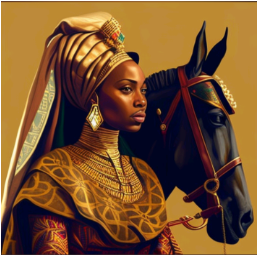There are legends of rulers, and historical accounts of luminaries of the past, whose impact on human history cannot easily be forgotten. In all of Africa, one such figure happened to be a daunting female ruler, namely Queen Amina of Zazzau (renamed Zaria in present-day Kaduna State). Her reign shook the entire Hausaland to the foundations. She led many successful military campaigns and conquered vast lands across the Hausa states and beyond with peculiar strategic prowess. She was an excellent warrior and controversial leader with strange tastes, and she excelled both on the battlefield and in issues of governance.
Queen Amina equally amassed incredible levels of wealth and resources on behalf of Zazzau. And till the present day, echoes of her footprints can still be heard across West Africa and beyond. Her legacy remains undying, far beyond the ancient and mighty city of Zaria and its neighbors. But her history has a dark side, not often emphasized (perhaps for ethical reasons, or out of respect for her – or both). It might have had a permanent impact on how the patriarchal society viewed Hausa women of the future. Nevertheless, Queen Amina of Zazzau remains a glowing and shocking example of what a visionary leader (and a focused woman) can achieve, all at once. However, there is a need for ethical considerations; and we must of necessity learn from history.
Queen Amina of Zazzau: Her Origins and Lifetime
We must highlight Queen Amina of Zazzau’s ascendancy to the throne, and the legacy that trailed her. Before and after her, few other rulers had such a mighty impact on human society.
Amina of Zazzau (also called Aminatu Sarauniya Zazzau) was the daughter of King Nikatau (the 22nd ruler of Zazzau) and Queen Bakwa Turunku. King Nikatau ruled sometime in the 16th Century CE. Her mother, Queen Bakwa Turunku, would later rule from 1536 to 1566 thereabout (according to historical records). Zazzau (or Zaria) was one of the largest of the seven original Hausa ancient city-states, or Hausa Bakwai. The others being Daura, Kano, Gobir, Katsina, Rano, and Garun Gabas. Amina had an elder brother named Karami, and a younger sister named Zaria. When the British forces arrived in the latter part of the 20th Century, Zaria’s name was chosen as the modern name for Zazzau.
Amina was a favorite of her grandfather and was brought up in her grandfather’s court. Additionally, her grandfather carefully groomed her in military and political affairs. She earned the name ‘Magajiya’ (heir apparent) and was so favoured that at 16 years of age, she was given 40 slaves. She also had some rich suitors who courted her from an early age (including the Sarkin Kano) with hefty gifts; which also included slaves. Slave gifting among the Hausa elites of that time was not uncommon. Zazzau was a major source of slaves for the slave markets of Kano and Katsina in that period.
However, Amina’s parents reportedly died sometime around 1566. Her brother Karami ascended her father’s throne and ruled until the year 1576 (when he died). But before then, Amina was a prominent military leader in her brother’s cavalry, with exceptional fighting skills. Following her brother’s death, Amina ascended the throne as queen.
Legend has it that within three months of becoming a monarch, Amina began a 34-year military campaign to broaden Zazzau territory. She took over neighbouring lands as far as south of the Niger-Benue confluence – right into places like Nupe and Kwararafa. Amina had a formidable and well-trained army of 20,000 foot soldiers and 1,000 cavalry troops to that effect. The queen also ensured that every city she conquered was fortified with strong earthen walls, most of which are still existing till date. They earned the name ganuwar Amina (Amina’s walls). Zazzau’s territories remained under its control until the British forces conquered the city-state in 1904.
However, she had the controversial tradition of taking a new lover in every town she visited. The entire affair would last only that night; as the unfortunate lover was doomed to be beheaded the following morning. There are strong speculations that Queen Amina carefully eliminated every potential claimant to her throne (aside from her only son) through that shocking ritual.
Queen Amina of Zazzau’s Legacy
Many historians claim that Queen Amina of Zazzau died in the Vom, Jos area. While some others claim she died in a place called Attaagar (or Atagara, near present-day Idah) in Nigeria. Accounts of 19th Century Muslim scholar Dan Tafa, and Sidney John Hogben, cite the latter claim in their works. Thus, they further stressed the extent to which the kingdom of Zazzau had covered, going as far as southwards of the Niger-Benue confluence towns. Zazzau by that time had become the largest Hausa city-state before the arrival of British forces. The circumstances of her death were, however, not known.
Following Queen Amina’s regime, women leaders were gradually eclipsed. And positions of authority and decision-making involving women were largely taken away over time. Amina’s formidable exploits and amassed wealth (combined with the inglorious execution of her 24-hour suitors) were fearsome memories in the history of Hausaland. Without any certainty, we might guess that an attempt for a female to replicate such notoriety or power was not openly welcome. Neither amongst the Hausa rulers nor amongst the British forces that took over in later years.
However, Queen Amina of Zazzau succeeded in creating extensive trade routes across Northern Africa, in addition to her renowned fortified territories. She also introduced the cultivation of kola nut as a cash crop in Hausaland. Yet again, Queen Amina was an exceptional strategist, a courageous and fearsome fighter, and a great defender of her people. She was able to unite and subdue many northern lands under her rule. She even mandated several vassal states (such as Katsina and Kano) to pay tributes to her.
The queen’s exploits were mentioned in a good number of historical records and artifacts (both local and international). Aside from the accounts of historians Dan Tafa and Sidney John Hogben, there were a host of others which included the following:
- The historical records of Muhammed Bello named Ifaq al-Maysur (written around the year 1836). He stated that Amina was ‘the first to establish government among [the Hausa]’.
- The Planisphere of Domingos Teixeira, a map made in 1573. In it, a place in Africa called ‘Castelo Damina’ (Castle of Amina) was named.
- The Kano Chronicle, created in the late 19th Century. It contains a detailed history of the city of Kano.








